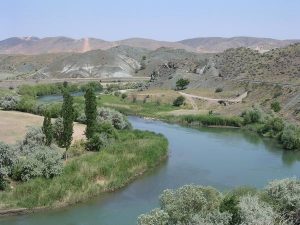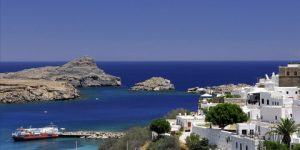Rivers are an important natural feature in Ancient Greece. In antiquity, they were worshipped as individual deities. The sea is the most consistent influence on the physical environment of Greece. Thus water bodies, primarily the rivers and seas, form a pivotal part in shaping the history of the Ancient Greeks. Apart from affecting the climate, they were also relevant in the day-to-day livelihood of the people.
The Greek coastline which is elaborately irregular is one of the longest in the world and includes about 15,000 kilometers of the shore. No point on the mainland is farther than 100 kilometers from the water, and Greece includes more than 2,000 islands–of which about 170 are inhabited. Crete (Kriti), the largest of the islands, is the southernmost point of the nation where a significant amount of the Greek population resides.

The Ancient Greeks believed that river landscapes were beautiful beyond human standards and were thus not meant primarily for humans and belonged to the world of the gods and goddesses. The largest river in Greece is the Aliakmonas (297 kilometers in length), followed by the Acheloos river, the Pineios river, the river of Evros, and the Mesta (Nestos) river. Apart from these large Greek rivers, a number of smaller streams and rivers are also found.
Large Rivers of Ancient Greece:
Aliakmonas:
Acheloos:
Pineios:
Evros:
Mesta:
Other Smaller Ancient Greek Rivers are:
Mylopotamos:
Mylopotamos is a small stream in Rethymno Prefecture, in northern Crete. It is a municipality in the Rethymno regional unit on the island of Crete.
Spercheios:
It is a tributary of the Spercheios river, which rises in Mountain Oeta. It is famous for its railway bridge which was blown up by the Greek Resistance during the German Occupation. This river is in Phthiots in Central Greece. It is worshipped as a god in Ancient Greece mythology and is also referenced in the play “Philoctetes”, written by Aeschylus, where it is quoted as a place for a cats in “The Frogs.”

Nedas:
Nedas are small Ancient Greek Rivers of the Western Peloponnese, forming the boundary between Ilia and Messenia Prefectures. It springs from the mountains framing the western basin of Megalopolis, runs west between Mountain Tetrazio and Kondovounia, and flows into the Cyparissian Gulf between Kyparissia and Zacharo (Ilia).
Eurotas:
Eurotas river is the chief river of Laconia Prefecture, named after the legendary king of Laconia, the grandson of Lelex and father of Sparta. It rises in the mountains between Laconia and Arcadia but also receives many rushing tributaries from Mountain Parnon and Taygetus. It drains the valley between the two and runs into the Gulf of Laconia, after irrigating the Elos plain.
Major Seas of the Ancient Greek World:
The Adriatic Sea
The Adriatic Sea is a water body that separates the Italian peninsula from the Balkan peninsula. It is the northernmost arm of the Mediterranean Sea, extending from the Strait of Otranto, where it gets connected to the Ionian Sea, in the northwest. It consists of Aoos/Vjos (near Novosel, Albania), Drino (in Tepelen, Albania), and the Ionian Sea. The rivers in this section are sorted from the north to the south (from the Albanian border to Cape Malea).

They include Thyamis (near Igoumenitsa), Acheron (near Parga), Arachthos (in Kommeno), Acheloos (near Astakos), Megdovas (near Fragkista), Agrafiotis (near Fragkista), Granitsiotis (near Granitsa), Evinos (near Messolonghi), Mornos (near Nafpaktos), Charadros (in Patras), Glafkos (in Patras), Peiros (in Dymi), Pineios (near Gastouni), Alfeios (near Pyr), Erymanthos (near Kallithea), Ladon (near Kallithea), Aroanios (near Filia), Lousios (near Gortyna), Neda (near Kyparissia), Pamisos (near Messene), Eurotas (in Elos).
The Aegean Sea
The Aegean Sea is an elongated extension of the Mediterranean Sea between Asia and Europe. It is located between the Balkan and Anatolia regions. It is connected to the Black Sea and the Marmara Sea in the north by the straits of Dardanelles and the Bosphorus. The Aegean islands located within the sea include Crete and Rhodes. The main subdivisions of the Aegean Sea are the Sea of Crete and the Thracian Sea.
The rivers in this section are sorted from the south (Cape Malea) to the northeast (Turkish border). They include the Inachos (in Nea Kios), Spercheios (near Lamia), Gorgopotamos (near Lamia), and Pineios (in Stomio). The Titarisios (in Ampelonas), Enipefs (in Farkadona), Haliacmon (in Methoni), Axios/Vardar (near Thessaloniki) are also the Aegean rivers.

Another extension of the Aegean rivers is from the Gallikos (near Thessaloniki), Strymonas/Struma (in Amphipolis), Nestos/Mesta (near Keramoti), Despatis/Dospat (near Sidironero), Evros/Maritsa (near Alexandroupoli), Erythropotamos/Luda Reka (near Didymoteicho), Areas/Arda (near Edirne, Turkey).
Conclusion:
In conclusion, we might identify some of the ancient streams and seasonal rivers of Greece. They include the Ammonites (stream which empties into the Lake Bolbe), Bisaltes (raicus), Alpheus, Erasinos (empties into the modern Petalies Gulf), Erections (empties into the Strymonic Gulf), Olympiakos (empties into the Lake Bolbe) and Rhodies (empties into Thermaic Gulf).